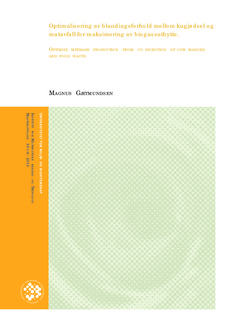| dc.description.abstract | Norge har satt seg ambisiøse mål for både økt produksjon av fornybar energi og reduksjon av
klimagassutslippene fra landbruket. Det skal etableres 13 TWh ny fornybar energi innen 2020,
samtidig skal landbruket kutte utslippene av klimagasser med 1,1 mill tonn CO2 ekvivalenter.
For å nå målet om reduserte klimagassutslipp i landbruket må implementering av biogassproduksjon
skje i stort omfang. Det vil føre til økt produksjon av fornybar energi. Gårdsbaserte biogassanlegg er
ikke vanlig i Norge. Anleggene er for dyre i forhold til inntektene, men vil kunne øke i lønnsomhet
hvis man kan produsere mer biogass på mindre anlegg. Gårdsbruk har god tilgang på næringsrikt
substrat fra egne dyr, og vil trenge tilgang på energirikt substrat, som matavfall, for å øke
biogassproduksjonen.
I denne oppgaven har blandingsforholdet mellom kugjødsel og matavfall for økt biogassproduksjon
ved anaerobisk våtråtning blitt undersøkt. Det har blitt benyttet fire CSTR reaktorer med 15 liter
aktivt reaktorvolum, operert i mesofil temperatur, 37 ± 2 °C. For å undersøke ett bredt spekter av
blandingsforhold, fra kun kugjødsel til 85 % matavfall, ble det benyttet to forsøksserier i reaktorene. I
første forsøksserie ble det brukt kun kugjødsel i reaktor R5 og kugjødsel blandet med henholdsvis
14.6, 24.5 og 32.2 % matavfall i R6, R7 og R8. Det gir organisk belastning på 1.8, 3.0, 4.0 og 5.0
g(VS)/(l*dag) og oppholdstid på 25, 22, 19 og 17 dager for følgende reaktorer R5, R6, R7 og R8.
Mengden kugjødsel var konstant for å imitere forholdene ved et gårdsanlegg. Ved overgang til andre
forsøksserie ble den organiske belastningen i alle reaktorene økt med ca 4 g(VS)/(l*dag).
Oppholdstiden ble fiksert til 17 dager i alle reaktorene, det gav en innblanding av 45, 58, 72 og 85 %
matavfall i kugjødsla. For å øke den organiske belastningen til ønsket nivå, kunne ikke mengden
kugjødsel holdes konstant, da oppholdstiden ville blitt alt for kort. Derfor ble oppholdstiden fiksert.
Underveis i andre forsøksserie brant forsøkslaboratoriet. På grunn av brannen er datagrunnlaget her
lite og har mange feilkilder.
Volumetrisk metanproduksjon steg fra 0.38 liter metan per liter reaktorvolum i reaktoren med kun
kugjødsel til 1.05, 1.59 og 2.21 liter metan per liter reaktorvolum i reaktorene med henholdsvis 14.6,
24.5 og 32.2% matavfall innblandet. Spesifikk metanproduksjon ble bestemt til 0.209, 0.350, 0.395 og
0.438 l(CH4)/(g(VS)), i reaktoren med innblanding av 0, 14.6, 24.5 og 32,2 % matavfall. Konverterbar
energi fra organisk del av kugjødsla ble funnet til 2,3 kWh per kilo VS og for matavfall til 6,2 kWh per
kilo VS. Øvre grense for organisk belastning ble bestemt til 6 g(VS)/(l*dag), 7 g(VS)/(l*dag) gav
inhibering med kraftig dropp i pH.
Forsøkene viser at en økning fra 14.6 % matavfall innblandet til 32.2 % kan gi en økning av
metanproduksjonen på hele 110 %. Norway has set ambitious goals for both increased production of renewable energy and the
reduction of greenhouse gases (GHG) emission from agriculture. Facilities for the annual
production of 13 TWh of new renewable energy and the annual reduction of agriculture
emissions of GHG by 1.1 mil CO2 equivalents are planned for completion by 2020.
To achieve the goal of reducing GHG emissions from agriculture will require a large increase
in the production of biogas. The biogas will be used to produce renewable energy. Biogas
plants at farm scale are too costly relative to revenues and are not used much in Norway.
Plants with a higher yield of methane per volume of feedstock can improve profitability.
Farms have access to manure and this is a nutritious substrate, but it needs a co-substrate with
high energy density to improve the methane yield.
This has been investigated using different ratios of cow manure and food waste to improve
biogas yield in anaerobic digestion by microorganisms. Four CSTR reactors, each are having
an active reactor volume of 15 liters have been used at mesofilic temperature, 37 ± 2 °C to
examine a wide range of mixing ratios. One hundred percent cow manure to 85 % food waste
in eight different mixing ratios has been evaluated in two trials. Trial one used 100% cow
manure in reactor R5, and cow manure mixed with 14.6, 24.5 and 32.2 % food waste in
reactors R6, R7 and R8 respectively. This yielded an organic loading rate of 1.8, 3.0, 4.0 and
5.0 g(VS)/(l*day) and a hydraulic retention time of 25, 22, 19 and 17 days respectively in
reactors R5, R6, R7 and R8. The mass of cow manure was held constant to match likely
conditions of a farm scale biogas plant. Transition to a second trial was done by increasing the
organic loading rate from 4.0 g to 9.0 g(VS)/(l*day) in each reactor. Hydraulic retention time
in this trial was fixed at 17 days in all the reactors. This was necessary because fixing the
amount of cow manure would have resulted in hydraulic retention times that were far too low.
The resulting mixing ratios were 45, 58, 72 and 85 % food waste.
During the second trial a fire at the laboratory resulted in the loss of much data and increased
sources for errors.
Volumetric methane yield increased from 0.38 litre methane per litre reactor volume from
digestion of 100% cow manure to 1.05, 1.59 and 2.21 litre methane per litre reactor volume
respectively for 14.6, 24.5 and 32.2 % food waste. Specific methane yield was determined to
be 0.209, 0.350, 0.395 and 0.438 l(CH4)/(g(VS)) in the reactors with cow manure mixed with
0, 14.6, 24.5 and 32.2 % food waste. Convertible energy from volatile solids in cow manure
was determined to 2.3 kWh per kilo VS and 6.2 kWh per kilo VS for food waste. An upper
organic loading rate limit was found to be 6 g(VS)/(l*day). A loading rate of 7 g(VS)/(l*day)
showed inhibition and a rapid decrease in biogas yield.
An increase in mixing ratio from 14.6 % to 32.2 % food waste in constant mass cow manure
can increase the methane yield by 110 %. | no_NO |
